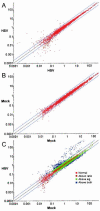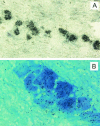Latent herpes simplex virus infection of sensory neurons alters neuronal gene expression
- PMID: 12915567
- PMCID: PMC187408
- DOI: 10.1128/jvi.77.17.9533-9541.2003
Latent herpes simplex virus infection of sensory neurons alters neuronal gene expression
Abstract
The persistence of herpes simplex virus (HSV) and the diseases that it causes in the human population can be attributed to the maintenance of a latent infection within neurons in sensory ganglia. Little is known about the effects of latent infection on the host neuron. We have addressed the question of whether latent HSV infection affects neuronal gene expression by using microarray transcript profiling of host gene expression in ganglia from latently infected versus mock-infected mouse trigeminal ganglia. (33)P-labeled cDNA probes from pooled ganglia harvested at 30 days postinfection or post-mock infection were hybridized to nylon arrays printed with 2,556 mouse genes. Signal intensities were acquired by phosphorimager. Mean intensities (n = 4 replicates in each of three independent experiments) of signals from mock-infected versus latently infected ganglia were compared by using a variant of Student's t test. We identified significant changes in the expression of mouse neuronal genes, including several with roles in gene expression, such as the Clk2 gene, and neurotransmission, such as genes encoding potassium voltage-gated channels and a muscarinic acetylcholine receptor. We confirmed the neuronal localization of some of these transcripts by using in situ hybridization. To validate the microarray results, we performed real-time reverse transcriptase PCR analyses for a selection of the genes. These studies demonstrate that latent HSV infection can alter neuronal gene expression and might provide a new mechanism for how persistent viral infection can cause chronic disease.
Figures




Similar articles
-
The transgenic ICP4 promoter is activated in Schwann cells in trigeminal ganglia of mice latently infected with herpes simplex virus type 1.J Virol. 2001 Nov;75(21):10401-8. doi: 10.1128/JVI.75.21.10401-10408.2001. J Virol. 2001. PMID: 11581408 Free PMC article.
-
Neuronal control of herpes simplex virus latency.Virology. 1993 Aug;195(2):337-47. doi: 10.1006/viro.1993.1384. Virology. 1993. PMID: 8393231
-
Persistent expression of chemokine and chemokine receptor RNAs at primary and latent sites of herpes simplex virus 1 infection.Virol J. 2004 Sep 23;1:5. doi: 10.1186/1743-422X-1-5. Virol J. 2004. PMID: 15507126 Free PMC article.
-
Use of laser capture microdissection together with in situ hybridization and real-time PCR to study distribution of latent herpes simplex virus genomes in mouse trigeminal ganglia.Methods Mol Biol. 2005;293:285-93. doi: 10.1385/1-59259-853-6:285. Methods Mol Biol. 2005. PMID: 16028427 Review.
-
Role of latency-associated transcript in herpes simplex virus infection.Intervirology. 1991;32(2):101-15. doi: 10.1159/000150190. Intervirology. 1991. PMID: 1851144 Review.
Cited by
-
Whole exome sequencing of patients with varicella-zoster virus and herpes simplex virus induced acute retinal necrosis reveals rare disease-associated genetic variants.Front Mol Neurosci. 2023 Oct 25;16:1253040. doi: 10.3389/fnmol.2023.1253040. eCollection 2023. Front Mol Neurosci. 2023. PMID: 38025266 Free PMC article.
-
Neuroinvasion and Inflammation in Viral Central Nervous System Infections.Mediators Inflamm. 2016;2016:8562805. doi: 10.1155/2016/8562805. Epub 2016 May 25. Mediators Inflamm. 2016. PMID: 27313404 Free PMC article. Review.
-
Recurrent Herpes Simplex Virus Type 1 (HSV-1) Infection Modulates Neuronal Aging Marks in In Vitro and In Vivo Models.Int J Mol Sci. 2021 Jun 11;22(12):6279. doi: 10.3390/ijms22126279. Int J Mol Sci. 2021. PMID: 34208020 Free PMC article.
-
Interplay Between CMGC Kinases Targeting SR Proteins and Viral Replication: Splicing and Beyond.Front Microbiol. 2021 Mar 29;12:658721. doi: 10.3389/fmicb.2021.658721. eCollection 2021. Front Microbiol. 2021. PMID: 33854493 Free PMC article. Review.
-
Host cell gene expression during human immunodeficiency virus type 1 latency and reactivation and effects of targeting genes that are differentially expressed in viral latency.J Virol. 2004 Sep;78(17):9458-73. doi: 10.1128/JVI.78.17.9458-9473.2004. J Virol. 2004. PMID: 15308739 Free PMC article.
References
-
- Adamec, E., P. S. Mohan, A. M. Cataldo, J. P. Vonsattel, and R. A. Nixon. 2000. Up-regulation of the lysosomal system in experimental models of neuronal injury: implications for Alzheimer's disease. Neuroscience 100:663-675. - PubMed
-
- Baldi, P., and A. D. Long. 2001. A Bayesian framework for the analysis of microarray expression data: regularized t-test and statistical inferences of gene changes. Bioinformatics 17:509-519. - PubMed
-
- Bartke, A., V. Chandrashekar, D. Turyn, R. W. Steger, L. Debeljuk, T. A. Winters, J. A. Mattison, N. A. Danilovich, W. Croson, D. R. Wernsing, and J. J. Kopchick. 1999. Effects of growth hormone overexpression and growth hormone resistance on neuroendocrine and reproductive functions in transgenic and knock-out mice. Proc. Soc. Exp. Biol. Med. 222:113-123. - PubMed
-
- Benovic, J. L., J. J. Onorato, J. L. Arriza, W. C. Stone, M. Lohse, N. A. Jenkins, D. J. Gilbert, N. G. Copeland, M. G. Caron, and R. J. Lefkowitz. 1991. Cloning, expression, and chromosomal localization of beta-adrenergic receptor kinase 2. A new member of the receptor kinase family. J. Biol. Chem. 266:14939-14946. - PubMed
Publication types
MeSH terms
Substances
Grants and funding
LinkOut - more resources
Full Text Sources
Other Literature Sources

